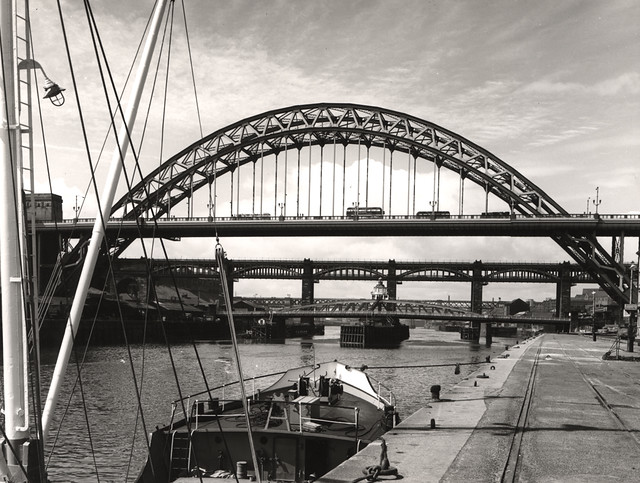Topics > Tyne and Wear > Newcastle upon Tyne > Newcastle, 1855 > Hospitals and Almshouses in Newcastle, 1855
Hospitals and Almshouses in Newcastle, 1855
Extract from: History, Topography, and Directory of Northumberland...Whellan, William, & Co, 1855.
HOSPITALS AND ALMSHOUSES.
THE HOSPITAL OF THE HOLY JESUS, Manor Chare. This institution, commonly called the Town's Hospital, was erected in the year 1682, upon a portion of the site of the suppressed Augustinian monastery. It was incorporated and endowed by the municipality under the 39th Elizabeth, c. 5, for the relief of freemen and freemen's widows, or the sons and daughters of freemen, and, by the deed of incorporation, it was declared that the mayor, aldermen, and common council of Newcastle for the time being, should be the visitors of this hospital. By this appointment of visitors, the Charity Commissioners were precluded from inquiring into the condition of this institution. The number of inmates, as regulated by act of parliament in 1847, consists of one master, twelve brethren, and thirty-seven sisters, each of whom receives £1 per lunar mouth, and is furnished with clothing and coals. The master receives £2 per annum extra. In addition to this, they receive yearly 13s. 4d. each from charities which have been left to the hospital. George Mather, master.
BLACKETT'S AND DAVISON'S HOSPITAL was situated in the Manor Chare, south of Jesus Hospital, but it was removed in 1847, in consequence of railway operations. It was erected by the corporation, in 1754, for the pensioners of Sir Waiter Blackett, and Mr. and Mrs. Davison's Charities, consisting of six poor widows of clergymen and merchants, six poor old bachelors, and six. poor unmarried women, daughters or widows of burgesses.
THE KEELMEN'S HOSPITAL is situated on the north side of the New Road. It is a brick structure, rather gloomy in appearance, containing fifty-four chambers, besides a large one in the south front for general meetings, and was erected in 1701, at a cost of upwards of £2,000, by the keelmen of the Tyne, for the benefit of those of their body who are disabled by sickness or lameness, and so prevented from pursuing their usual employment. This institution reflects the highest credit upon the keelmen, and is, perhaps, the only hospital in the kingdom built and supported by the working classes for the benefit of their own members.
THE PEACE AND UNITY HOSPITAL, Westgate-street, is a neat building, in the Gothic style, erected by the corporation in 1814, for the support of forty indigent old freemen, or freemen's widows, and unmarried daughters. The inmates receive £1 each per lunar month, and are provided with coals, the governor receiving £2 per annum extra. The ''Municipal Corporations Act," passed in 1835, secured these allowances to those who were inmates at that time, for their lives, but the vacancies caused by death since that period have not been filled up:
ST. MIARY MAGDALEN'S HOSPITAL. We have no authentic account of the original foundation of this hospital, but tradition tells us that it owes its origin to Henry I., who, "when the leproacy was raging with great violence in the kingdom, and almost every town was provided with a lazar house, built this hospital for a master, brethren, and three sisters, who were to receive persons afflicted with the pestilence." It came to the sovereign by the statutes of Henry VIII. and Edward VI., and remained vested in the crown till the time of James I., who incorporated it with the chapel of St. Thomas a Becket, at the end of Tyne bridge. By the charter of incorporation it was decreed that the united institutions should consist of a master, who was at least to be a master of arts, and three old, poor, and unmarried burgesses of the town, who should be a body corporate in law, with the usual rights and privileges. The mayor and common council of Newcastle-upon-Tyne to be patrons, with the right of presentation, and power to renew and alter the statues. In 1827 an act of parliament was obtained, by which the master and brethren were empowered to grant building leases of the property belonging to this hospital, which is of considerable extent in Newcastle, and the act has since been extensively acted upon. At the time of the Charity Commissioners' Report the income of this hospital amounted to £983. 11s. 6d. per annum.
HOSPITAL OF ST MARY THE VIRGIN. We have met with no authentic account of the original foundation of this hospital, but it probably came to the crown by the statutes of Henry VIII. and Edward VI., in the same manner as the hospital of St. Mary Magdalen. In 1611 King James I. granted a new charter to this hospital, "Constituting the foundation, to consist of a master and six unmarried poor old men, incorporated and having a common seal, with power to let leases, etc. The mayor and burgesses of Newcastle to be the patrons. The annual income of this institution amounted to £41. 19s. 8d. at the time of the Charity Commissioners' Report, but it has since been increased by a change in the manner of granting leases of the property belonging to this hospital. The almshouse is an incommodious and confined building in Pudding-Chare, containing separate apartments for six poor men, who receive £6 each per annum, besides an allowance for coals.
Also in this Directory (Whellan, 1855) for Newcastle:
- Description of Newcastle
- Early history
- Fire of Newcastle & Gateshead (1854)
- Extinct Monastic Edifices
- Fortifications, etc.
- Churches and Chapels
- Public schools
- Hospitals and Almshouses
- Benevolent Societies and Institutions
- Public Civil Buildings, etc.
- Literary and Scientific Societies, etc
- Commerce and Manufacturers, etc.
- Corporation, etc.
- General Charitities of Newcastle-upon-Tyne
- Eminent Men
- Post Office, Newcastle
- Directory of Newcastle-upon-Tyne










